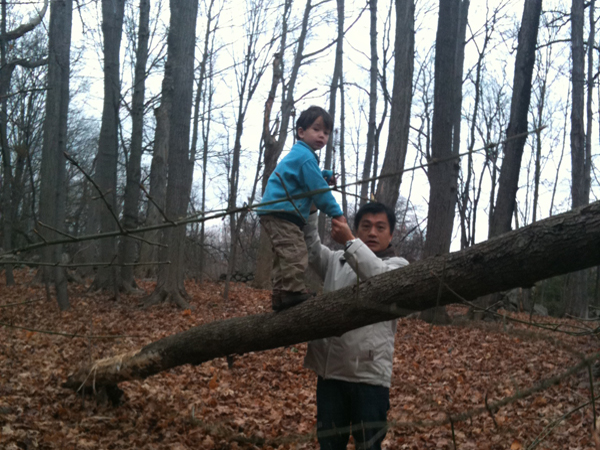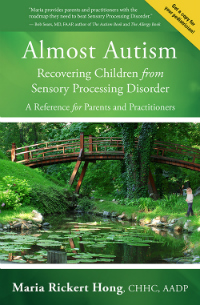 When my older son was 3-1/2, I finally learned that he had sensory processing disorder (SPD); this realization let me recognize the signs later on that my younger son had it as well.
When my older son was 3-1/2, I finally learned that he had sensory processing disorder (SPD); this realization let me recognize the signs later on that my younger son had it as well.
My older son began seeing an occupational therapist (OT) when he was 3-1/2 years old. Before his first visit, she had me fill out two questionnaires: a sensory profile caregiver questionnaire and a foundational listening skills assessment sensory checklist.
The answers I gave provided a foundation for her to plan sessions with my son. She noted that my primary reasons for seeking her services were my son’s muscle weakness, decreased ability to play with others in a physical manner, and general anxiety.
Sensory Profile Caregiver Questionnaire
From the caregiver questionnaire, the OT concluded that my son had probable differences (scores between 1 and 2 standard deviations below the mean) in auditory, visual, vestibular and multi-sensory processing.
She noted that he had a definite difference (more than 2 standard deviations below the mean) in oral sensory processing.
She evaluated his modulation, which “reflects the child’s regulation of neural messages through facilitation or inhibition of various types of responses”.
My son displayed a probable difference in modulation related to body position and movement and definite differences in sensory processing related to endurance/tone and in sensory input affecting emotional responses.
He also showed a probable difference in inattention/distractibility and definite differences in being emotionally reactive (remember all that crying?), low endurance/tone, oral sensitivity, sensory sensitivity and in being sedentary.
He also exhibited definite differences in his emotional/social responses and in his behavioral outcome of sensory processing.
Foundational Listening Skills Assessment Sensory Checklist
From the foundational listening skills assessment sensory checklist, she assessed each of his processing systems.
Although my son scored in the typical performance range for tactile processing, he showed some areas of concern such as “avoids wearing shoes, prefers to be barefoot and doesn’t seen to notice when hands and face are messy” and “is very good at hiding pain”.
The OT stated that my son appeared to be hypersensitive to sound in reference to him frequently responding “negatively to unexpected loud noises” and to when he stopped what he was doing in her office to acknowledge sounds he heard from outside.
Vestibular Processing Is Key
The most important takeaway I got from the sensory checklist was my understanding of my son’s scoring a probable difference in vestibular processing, which is responsible for balance and the sense of movement; it is located in both inner ears.
I believe this to be the crux of the matter.
The OT stated that “the vestibular system is a primary organizer of sensory input in the central nervous system and integrates this information for all of the other sensory systems.
It tells us where our head is in space and how fast we are moving. It also has a strong influence on the body’s muscle tone and strength as well as helping to maintain a calm, alert state.”
Aha! Now it was all starting to make sense.
She noted that my son’s balance was below normal limits and that he “appeared fearful of movement as witnessed on the swings and tended to keep his head in an upright position”.
This is why he avoided playground equipment and spent most of his time in sedentary play.
Gravitational Insecurity
She told me that he had “gravitational insecurity” because he didn’t understand where his body was in space; he didn’t have a reference point because his internal gyroscope was out of balance.
Now I understood why he got car sick so often.
She also said that because of being so overwhelmed at all these stimuli that were coming at him and not being able to process them that he was scared to be in his own body. How sad!
Vestibular Sense Affects Proprioceptive Sense
Because his vestibular system was out of balance, so was his proprioceptive sense, otherwise known as “position sense” or “muscle sense”.
It “gives information about the position of the body without using the eyes and about how much force or pressure is needed to exert to complete a task”, such as throwing a ball.
The OT noted that my son moved in a “guarded” manner, suggesting that he “moved his body in a calculated manner to protect him from movements that didn’t feel safe”.
This is why he felt like a little limp Raggedy Andy doll when I picked him up; his proprioceptive sense wasn’t working correctly because his vestibular system wasn’t working correctly.
Multi-Sensory Processing Out of Whack
The OT explained that my son’s multi-sensory processing wasn’t working correctly, either. He easily became overwhelmed at too much sensory information (lights, noises, etc.) and would shut down.
She wrote that “when children feel out of control of their bodies with multi-sensory input, they may react to everyday challenges with increased emotional responses.” That described my son to a T.
Six-Week Evaluation
We agreed that she would evaluate him for six sessions and then she would write an evaluation.
During these sessions, she tested his abilities such as gross motor coordination: Could he jump 2 inches off the floor? Could he walk heel-to-toe? Could he hop on one foot at a time?
These were things he should’ve been able to do by the age of 3, but he still couldn’t.
She also tested his fine motor coordination and noted that he used an immature grasp and was unable to draw a cross or a square, although he could draw horizontal and vertical lines and a circle.
She evaluated his physical status and noted that he had average to low muscle tone and weak upper and lower extremities.
He was unable to hold the “superman” position (where you lie on your tummy and lift both your arms and legs up off the floor) and was able to make himself into a ball for only a few seconds.
We began seeing immediate results with the OT, even during the six-week evaluation period. Finally!
The exercises that she would have my son do, such as swinging on different therapy swings, climbing through tunnels, balancing on one foot, walking heel-to-toe in a straight line, etc., worked on his balance and core strength and gave him strength and confidence very quickly.
She also gave him exercises to do every day at home such as doing a “superman”, making himself into a ball and holding the position, rolling like a log, and standing like a statue with his eyes open and closed.
She explained that any way that we could get him to move his head in other than a typical position would send information to his vestibular system by making all the fluid and hairs in his inner ears move around and would work to correct his gravitational insecurity.
A Happier and More Physical and Social Kid
Within a few weeks of therapy (one day a week), my son became happier and less fearful. He also started tackling us as if he were a football player! He had never been so physical with us before, and it made me so happy to see him acting like a typical kid his age.
His teachers at preschool noticed a change, too: they couldn’t believe he was the same little boy. He had become much more outgoing and was now the same chatterbox there that he was at home.
He loved show-and-tell now and was eager to tell his stories to his classmates. When he started preschool, he engaged in parallel play, and you couldn’t get him out of the sand box.
By the end of the school year, he had had three months of occupational therapy, and he had moved up to associative play.
He even began playing on some of the playground equipment and going on swings and slides! I had been trying to get him to do that since he was a little baby, but he had always cried and refused to do it.
Prior to having OT, my son would always prefer to be with adults, probably because we were more sedentary and predictable than little kids.
After receiving OT, his increased confidence allowed him to begin making friendships with children his age. His OT and I agreed that the ultimate goal of working with her was for him to make friends.
I wasn’t expecting my son to become a world-class athlete; I simply wanted him to feel more comfortable with being in his body so that he could make friends. I didn’t want to doom him to a life of being socially isolated.
This was a tough, but necessary, choice for us because my husband had been recently laid off from his job. Insurance did not cover the OT sessions, and they weren’t cheap, but I became convinced after seeing such immediate results that they were well worth it.
It was important to correct his imbalances while his brain and nervous system were still growing and developing; trying to correct them at a later age wouldn’t have as much of an impact.
The OT said that it was much easier to work with a child like him because he was a sensory avoider; it was like getting him to come out of a box. It was much harder to work with sensory seekers because it was like trying to stuff them back into a box.
My son worked with the OT for six months, at which time she dismissed him for having “strong muscles”.
I can’t say enough good things about her and how much she helped my son. She recommended that he keep up his level of physical activity and said that she liked tae kwon do because of crossing the midline, which helps improve coordination. She also recommended an aquatic OT to help with his swimming.



We have a time timer for our 3 year old son and 18 month old daughter.We use it to help them tsiarntion through activities throughout the day and teach them about the passing of time. A great example is nap time which used to be a difficult time of day until we started with the time timer. Here’s how I use it: First, I explain to my son that when the time timer goes beep beep it will be time for bed. I set the timer for around 30 minutes (or whenever nap time is supposed to be) and my son and I settle into an activity. Throughout our play I ask him how much red he has left and if he wants to do more things, he’ll make sure to move on to the next activity before the red disappears. When the red is gone there is a quiet, short tone sounds. I intentionally bought the product with the tone for this very reason its not loud or on-going like an alarm clock so you’ll need to stay close by but its just enough to get your attention. My son shouts out beep beep’ and gets up and heads to his room. He’s getting to the point that he doesn’t need us to remind him to watch the time but instead, he points it out to us as if to say look how much red is left! I have read the previous reviews that say its flimsy. I think the time timer is a tool that we as parents / educators use and then set it up on the shelf for the children to watch. I didn’t want my son to play with it as I was concerned he would want to change the time, drop it, etc.This is a great product for teach toddlers how to tsiarntion, maintaining routine (which toddlers thrive with!) and helping them learn about time management.